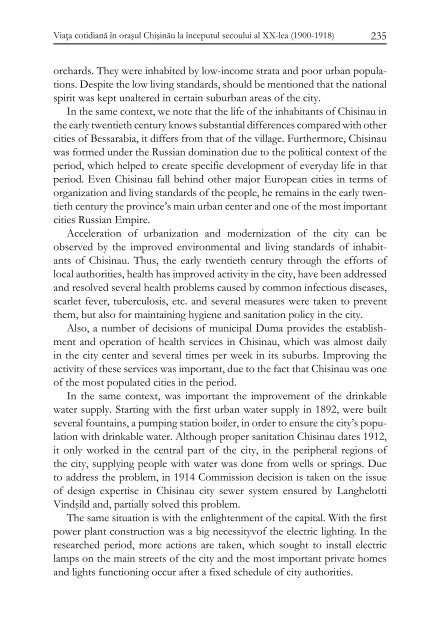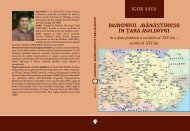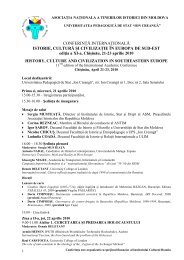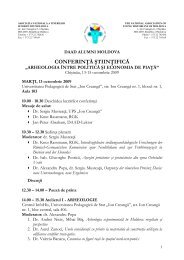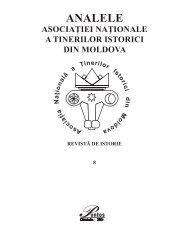LUCIA SAVA, Viaţa cotidiană în oraşul Chişinău la - Asociatia ...
LUCIA SAVA, Viaţa cotidiană în oraşul Chişinău la - Asociatia ...
LUCIA SAVA, Viaţa cotidiană în oraşul Chişinău la - Asociatia ...
Create successful ePaper yourself
Turn your PDF publications into a flip-book with our unique Google optimized e-Paper software.
<strong>Viaţa</strong> <strong>cotidiană</strong> <strong>în</strong> <strong>oraşul</strong> <strong>Chişinău</strong> <strong>la</strong> <strong>în</strong>ceputul secoului al XX-lea (1900-1918)<br />
235<br />
orchards. They were inhabited by low-income strata and poor urban popu<strong>la</strong>tions.<br />
Despite the low living standards, should be mentioned that the national<br />
spirit was kept unaltered in certain suburban areas of the city.<br />
In the same context, we note that the life of the inhabitants of Chisinau in<br />
the early twentieth century knows substantial differences compared with other<br />
cities of Bessarabia, it differs from that of the vil<strong>la</strong>ge. Furthermore, Chisinau<br />
was formed under the Russian domination due to the political context of the<br />
period, which helped to create specific development of everyday life in that<br />
period. Even Chisinau fall behind other major European cities in terms of<br />
organization and living standards of the people, he remains in the early twentieth<br />
century the province’s main urban center and one of the most important<br />
cities Russian Empire.<br />
Acceleration of urbanization and modernization of the city can be<br />
observed by the improved environmental and living standards of inhabitants<br />
of Chisinau. Thus, the early twentieth century through the efforts of<br />
local authorities, health has improved activity in the city, have been addressed<br />
and resolved several health problems caused by common infectious diseases,<br />
scarlet fever, tuberculosis, etc. and several measures were taken to prevent<br />
them, but also for maintaining hygiene and sanitation policy in the city.<br />
Also, a number of decisions of municipal Duma provides the establishment<br />
and operation of health services in Chisinau, which was almost daily<br />
in the city center and several times per week in its suburbs. Improving the<br />
activity of these services was important, due to the fact that Chisinau was one<br />
of the most popu<strong>la</strong>ted cities in the period.<br />
In the same context, was important the improvement of the drinkable<br />
water supply. Starting with the first urban water supply in 1892, were built<br />
several fountains, a pumping station boiler, in order to ensure the city’s popu<strong>la</strong>tion<br />
with drinkable water. Although proper sanitation Chisinau dates 1912,<br />
it only worked in the central part of the city, in the peripheral regions of<br />
the city, supplying people with water was done from wells or springs. Due<br />
to address the problem, in 1914 Commission decision is taken on the issue<br />
of design expertise in Chisinau city sewer system ensured by Langhelotti<br />
Vindşild and, partially solved this problem.<br />
The same situation is with the enlightenment of the capital. With the first<br />
power p<strong>la</strong>nt construction was a big necessityvof the electric lighting. In the<br />
researched period, more actions are taken, which sought to install electric<br />
<strong>la</strong>mps on the main streets of the city and the most important private homes<br />
and lights functioning occur after a fixed schedule of city authorities.


